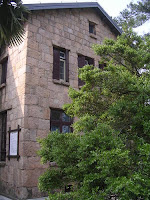China Cuckoo – A Useful History of Moganshan
Posted: January 13th, 2009 | 1 Comment » This is a sort of a pre-review in the sense that Mark Kitto’s book China Cuckoo isn’t published till late February but I got a chance to read a copy in advance. I’m not sure quite what the reviewers will make of it – I’d expect they’ll reach for the comparisons and see it as a rural Chinese version of Peter Mayle’s A Year in Provence and Chris Stewart’s Driving Over Lemons and A Parrot in the Pepper Tree. Actually, though I’ve personally never warmed to Mayle, these comparisons would not be totally inaccurate – and may Kitto have even a fraction of Mayle of Stewart’s sales!
This is a sort of a pre-review in the sense that Mark Kitto’s book China Cuckoo isn’t published till late February but I got a chance to read a copy in advance. I’m not sure quite what the reviewers will make of it – I’d expect they’ll reach for the comparisons and see it as a rural Chinese version of Peter Mayle’s A Year in Provence and Chris Stewart’s Driving Over Lemons and A Parrot in the Pepper Tree. Actually, though I’ve personally never warmed to Mayle, these comparisons would not be totally inaccurate – and may Kitto have even a fraction of Mayle of Stewart’s sales!
The format is basically English entrepreneur builds it all up from nothing, loses it all, retains his sense of humour and maintains his sang froid in the face of a nastily vengeful Communist bureaucracy only to discover another life post-Shanghai bandit capitalism on a mountaintop retreat where he starts another seemingly successful business with a determinedly slower pace of life and finds a modicum of contentment. It’s not a new theme, but it is a good one worth returning to and right now many who’ve spent the last few years slaving for the corporate machine to achieve next to nothing should warm to it.
But this is a history blog so I’m going to focus on that aspect of the book. Even if you couldn’t care less about a bloke named Kitto who got screwed and then started a hotel (which is rather nice – click here ) in the godforsaken countryside that most of us don’t care much for, China Cuckoo is effectively the first history in English of the Moganshan resort about 60km outside Hangzhou, a mini Swiss Alps in the middle of China.
 Moganshan is a classic hill retreat but has often been overlooked in books about hill stations in Asia (even Barbara Crossette’s otherwise excellent The Great Hill Stations of Asia doesn’t mention it if I recall correctly). For my money it’s among the best, a view further reinforced by a stay in Malaysia’s Cameron Highlands earlier this year which is like Piccadilly Circus on a messy Wednesday rush hour compared to Moganshan.
Moganshan is a classic hill retreat but has often been overlooked in books about hill stations in Asia (even Barbara Crossette’s otherwise excellent The Great Hill Stations of Asia doesn’t mention it if I recall correctly). For my money it’s among the best, a view further reinforced by a stay in Malaysia’s Cameron Highlands earlier this year which is like Piccadilly Circus on a messy Wednesday rush hour compared to Moganshan.
Moganshan was  always officially Chinese territory though the treaty porters of Shanghai and elsewhere congregated there for the summers. Kitto nicely recaptures the early days, the hey day and the sad demise of the resort. I had never realized it was as multi-racial as Kitto indicates – wealthy old school Brits alongside arriviste Americans, refugee-made-good Jews and wealthy and influential Chinese, including Chiang Kai-shek of course. Kitto also retells some of the legends of the old Moganshan – murders, scandals and Mao’s rumoured overnight stay. He illustrates the history with a liberal sprinkling of nice quotes from the old North-China Daily News.
always officially Chinese territory though the treaty porters of Shanghai and elsewhere congregated there for the summers. Kitto nicely recaptures the early days, the hey day and the sad demise of the resort. I had never realized it was as multi-racial as Kitto indicates – wealthy old school Brits alongside arriviste Americans, refugee-made-good Jews and wealthy and influential Chinese, including Chiang Kai-shek of course. Kitto also retells some of the legends of the old Moganshan – murders, scandals and Mao’s rumoured overnight stay. He illustrates the history with a liberal sprinkling of nice quotes from the old North-China Daily News.
Plenty of others I’m sure will review the book and I think it’ll be only the usual professionally churlish, jealous and trash-for-trashings-sake reviewers who will not like it. I’ll leave the professionals to do the reviewing but thought it worth noting that this is a useful read for those with a modern China history focus.
Sorry I don’t have any old photos of Moganshan in my collection – but Kitto has put some on his site
You have a great blog with fascinating topics and resources. Keep up the excellent work!
Neal
USA